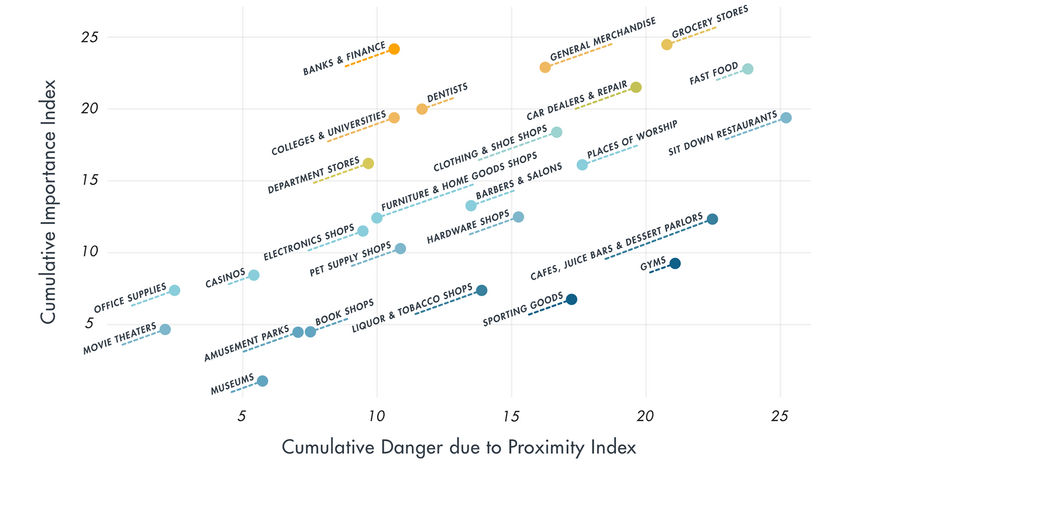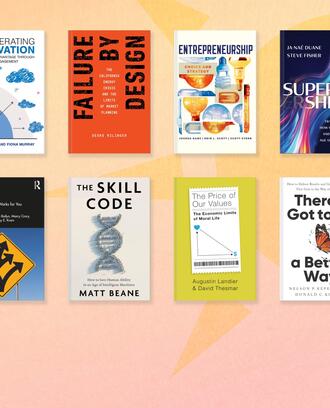Credit: Mimi Phan / Unsplash
As state and local governments decide how and when to reopen businesses and public places, a new study from MIT researchers offers a framework to help policymakers decide what should open first and which locations should face strict restrictions for longer.
The working paper from MIT Initiative on the Digital Economy researchers Seth Benzell, Avinash Collis, and Christos Nicolaides uses a cost-benefit analysis to rank each of 26 locations in terms of the tradeoff between relative risk of infection and importance to consumers and the economy. The researchers found banks, grocery stores, general merchandise stores like Walmart, and colleges and universities should face overall lighter restrictions and reopen earlier, while gyms, cafes, and liquor, tobacco, and sporting goods stores should face tighter restrictions and open later.
While all physical proximity is potentially dangerous during the pandemic, the researchers said an empirical study of the risks and benefits of different locations can help guide officials and policymakers, who have so far enacted widely varied closing and reopening plans. In Nebraska, day cares stayed open but liquor stores were closed, while the opposite was true in Massachusetts. Georgia began its economic reopening with barbershops, tattoo parlors, gyms, bowling alleys, and nail salons.
“Policymakers seem to be making decisions quickly and without a clear or transparent procedure,” Collis said.
“We want to give them an additional tool so they can make a better-informed decision,” Benzell added.
Here’s a look at how policymakers and other government leaders can use the framework to guide reopening decisions:
Know the benefits and potential risks of different types of locations
Using anonymous geolocation data from mobile phones in February and March 2020, the researchers calculated the transmission risk of 26 location types, like museums, movie theaters, cafes, and hardware stores. The cumulative transmission risk of a location is based on four measures of social contact, starting with number of visits and number of unique visitors.
The other metrics look at how crowded locations become through “person-hours” — the amount of time people spend there — of visits during crowding of more than one visitor for every 113 square feet, or a six-foot radius circle, and person-hours of visits during crowding of more than one visitor for every 215 square feet, the German guideline of one person for every 20 square meters. (Germany’s COVID-19 strategy has been seen as particularly successful, with declining cases and early plans for reopening its economy.)
The researchers also investigated complementary measures of transmission risk, including visits by individuals 65 and older, the amount of distance travelled to a location, and the share of jobs at a location that require close physical proximity to perform.
The benefits of different locations were determined by their contributions to the economy and how much they are valued by consumers. To determine consumer value, the researchers commissioned a nationally representative survey of 1,099 U.S. residents between April 13 and April 15. The respondents were asked to choose which location out of two they’d prefer to be open. Economic contributions were determined by the locations’ annual payrolls, receipts, and employment data.
More COVID-19 research from MIT Sloan
Rank and compare locations
The researchers compared locations two ways. The first measure compared the 26 locations against each other to see if any were superior to any others along all measures of risk and benefit. They also created an index of danger (or risk of transmission) versus importance. In most cases, the danger of a location, as determined by frequency and length of visits, is positively correlated with its importance — for example, grocery stores are found to have a relatively high transmission risk but high importance as well, as indicated by the fact that they’ve remained open.
Half of the locations did not prove to be strictly more beneficial or dangerous than other categories. Other locations did fall into a clear hierarchy. General merchandise stores, furniture and electronics stores, and colleges should face looser restrictions than gyms, juice bars, and sporting goods, liquor, and tobacco stores, the researchers found.
“Banks should be reopened before many types of locations, while cafes and gyms should be seventh in line at most,” the researchers said. “Places of worship should be reopened before gyms but after colleges and universities.”
The color scale reflects the residuals by category of a linear regression of the importance index on the danger index. Golden categories have disproportionately high importance for their risk, blue categories have disproportionately low importance.
Graph adapted from Rationing Social Contact During the COVID-19 Pandemic by Benzell, Collis, and Nicolaides. Designed by Johnny Amarantos.The study also looked at the data in terms of metro versus non-metro locations and places frequented by people who are 65 and older but found minimal differences across the categories.
The study indicates the overall danger of having regular traffic to a location, not the danger for an individual visit. “You are looking through the eyes of policymakers, not through the eyes of an individual,” said Nicolaides, a faculty member at the University of Cyprus.
Look for the outliers or special cases
Between February and March 2020, the researchers found a 25% drop in traffic to the locations they studied, a result of closures and social distancing measures. They observed larger declines in locations that their framework indicated should be closed first, showing that a cost-benefit sort of analysis is already being used by policymakers, businesses, and individuals.
The study also found several notable declines and increases in activity between February and March, the result of federal and local actions combined with decisions by businesses and individuals. Colleges — at least in their core missions of instruction and research — are a relatively good trade-off, the researchers found, but many have moved to remote learning since March. They contribute greatly to economic and social value but tend to have large campuses which are attended by a regular group of people. Dormitories and college parties constitute additional risks, but were not directly measured by researchers.
Liquor and tobacco stores are relatively poor trade-offs because they are often small and crowded and have low economic impact, yet visits there have declined by less than 5%. Hardware stores have seen the largest increase in visits, likely because people are buying personal protective equipment and other household supplies.
The researchers noted a few limiting factors to their framework. Physical shutdowns have different economic impacts for different industries — shutting down physical locations makes less of a difference for a bank than for a barbershop. The study also doesn’t account for linkages between industries in which one closing leads to more or less revenue or visits to others.
Outdoor public areas and parks could have value in terms of physical or mental health that are not accounted for, the researchers pointed out. And they noted there might be subtle variances in different geographic areas — for example, some states may have gyms that are large and uncrowded.
The researchers said they are continuing to refine and adjust their framework, and welcome hearing from people who are interested in using it as a tool, or anyone who has ideas about how to improve it.
“We give [policymakers] a baseline, we give them a framework, and then they should use their own unique characteristics,” Collis said. “This is something that each one of those states or cities should do themselves and also use their intuition, their unique cultural characteristics.”




